A Report on Legal Issues Affecting VR Projects in Australia
VerifiedAdded on 2023/06/11
|6
|1397
|460
Report
AI Summary
This report examines the legal issues surrounding virtual reality (VR) projects in Australia, focusing on intellectual property, user safety, ownership, copyright, and regulation. It highlights how Australian laws, such as the Property Law Act 1974, impact VR project ownership and the rights of developers. The report also discusses copyright limitations, international treaties like the Universal Copyright Convention, and the importance of government regulation in managing VR technology, particularly in medical applications. The analysis includes the role of patents and contracts in controlling the application of VR, aiming to protect users and the market from potential harm.
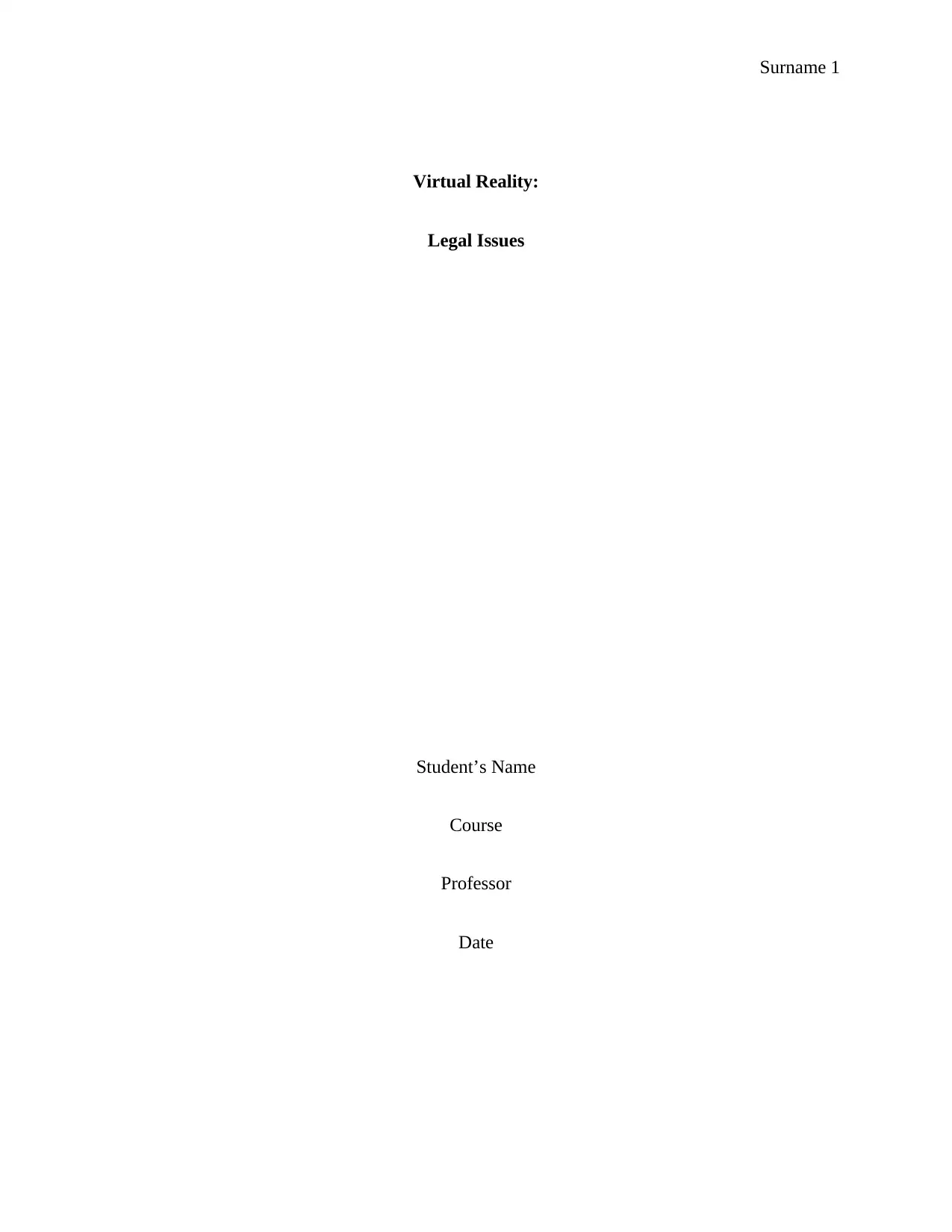
Surname 1
Virtual Reality:
Legal Issues
Student’s Name
Course
Professor
Date
Virtual Reality:
Legal Issues
Student’s Name
Course
Professor
Date
Paraphrase This Document
Need a fresh take? Get an instant paraphrase of this document with our AI Paraphraser
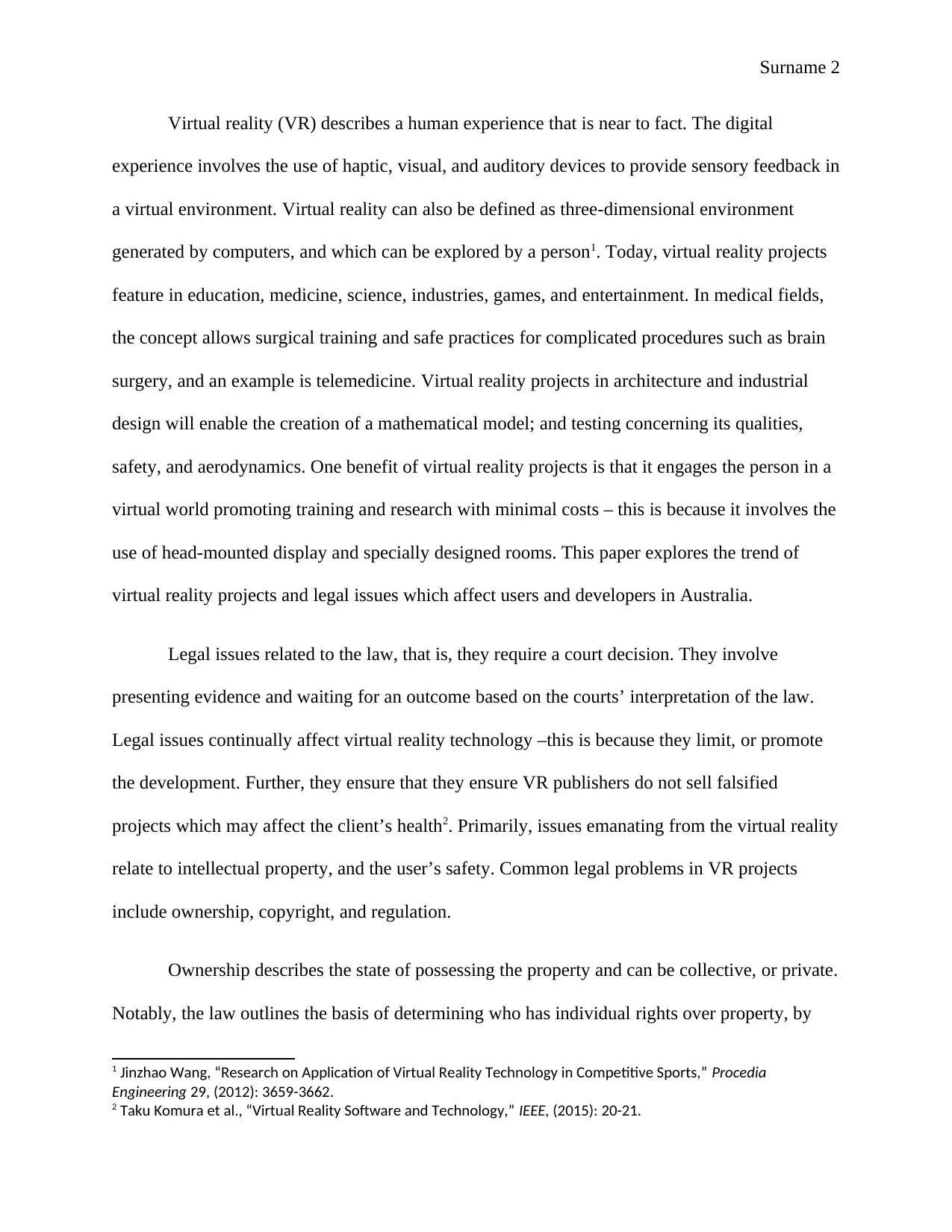
Surname 2
Virtual reality (VR) describes a human experience that is near to fact. The digital
experience involves the use of haptic, visual, and auditory devices to provide sensory feedback in
a virtual environment. Virtual reality can also be defined as three-dimensional environment
generated by computers, and which can be explored by a person1. Today, virtual reality projects
feature in education, medicine, science, industries, games, and entertainment. In medical fields,
the concept allows surgical training and safe practices for complicated procedures such as brain
surgery, and an example is telemedicine. Virtual reality projects in architecture and industrial
design will enable the creation of a mathematical model; and testing concerning its qualities,
safety, and aerodynamics. One benefit of virtual reality projects is that it engages the person in a
virtual world promoting training and research with minimal costs – this is because it involves the
use of head-mounted display and specially designed rooms. This paper explores the trend of
virtual reality projects and legal issues which affect users and developers in Australia.
Legal issues related to the law, that is, they require a court decision. They involve
presenting evidence and waiting for an outcome based on the courts’ interpretation of the law.
Legal issues continually affect virtual reality technology –this is because they limit, or promote
the development. Further, they ensure that they ensure VR publishers do not sell falsified
projects which may affect the client’s health2. Primarily, issues emanating from the virtual reality
relate to intellectual property, and the user’s safety. Common legal problems in VR projects
include ownership, copyright, and regulation.
Ownership describes the state of possessing the property and can be collective, or private.
Notably, the law outlines the basis of determining who has individual rights over property, by
1 Jinzhao Wang, “Research on Application of Virtual Reality Technology in Competitive Sports,” Procedia
Engineering 29, (2012): 3659-3662.
2 Taku Komura et al., “Virtual Reality Software and Technology,” IEEE, (2015): 20-21.
Virtual reality (VR) describes a human experience that is near to fact. The digital
experience involves the use of haptic, visual, and auditory devices to provide sensory feedback in
a virtual environment. Virtual reality can also be defined as three-dimensional environment
generated by computers, and which can be explored by a person1. Today, virtual reality projects
feature in education, medicine, science, industries, games, and entertainment. In medical fields,
the concept allows surgical training and safe practices for complicated procedures such as brain
surgery, and an example is telemedicine. Virtual reality projects in architecture and industrial
design will enable the creation of a mathematical model; and testing concerning its qualities,
safety, and aerodynamics. One benefit of virtual reality projects is that it engages the person in a
virtual world promoting training and research with minimal costs – this is because it involves the
use of head-mounted display and specially designed rooms. This paper explores the trend of
virtual reality projects and legal issues which affect users and developers in Australia.
Legal issues related to the law, that is, they require a court decision. They involve
presenting evidence and waiting for an outcome based on the courts’ interpretation of the law.
Legal issues continually affect virtual reality technology –this is because they limit, or promote
the development. Further, they ensure that they ensure VR publishers do not sell falsified
projects which may affect the client’s health2. Primarily, issues emanating from the virtual reality
relate to intellectual property, and the user’s safety. Common legal problems in VR projects
include ownership, copyright, and regulation.
Ownership describes the state of possessing the property and can be collective, or private.
Notably, the law outlines the basis of determining who has individual rights over property, by
1 Jinzhao Wang, “Research on Application of Virtual Reality Technology in Competitive Sports,” Procedia
Engineering 29, (2012): 3659-3662.
2 Taku Komura et al., “Virtual Reality Software and Technology,” IEEE, (2015): 20-21.
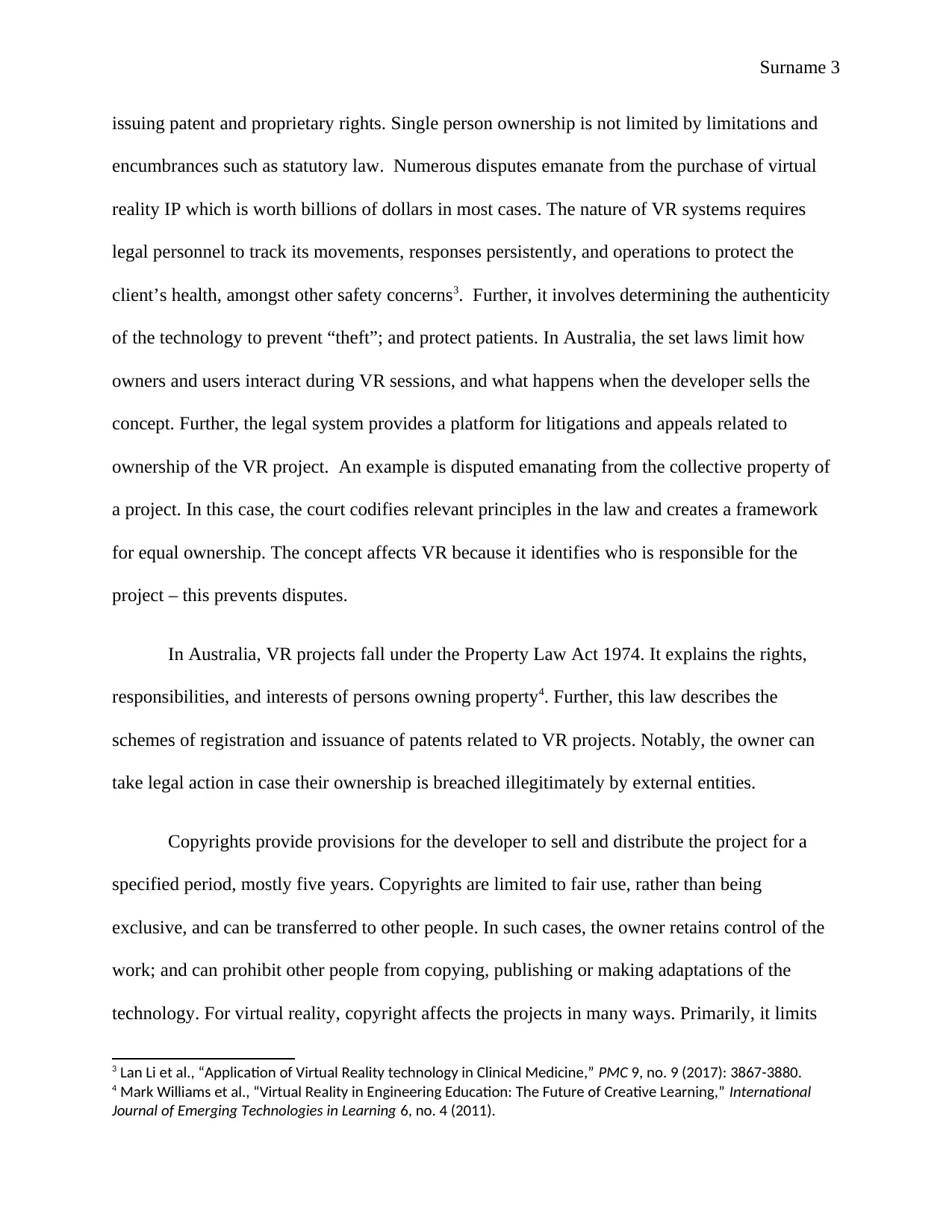
Surname 3
issuing patent and proprietary rights. Single person ownership is not limited by limitations and
encumbrances such as statutory law. Numerous disputes emanate from the purchase of virtual
reality IP which is worth billions of dollars in most cases. The nature of VR systems requires
legal personnel to track its movements, responses persistently, and operations to protect the
client’s health, amongst other safety concerns3. Further, it involves determining the authenticity
of the technology to prevent “theft”; and protect patients. In Australia, the set laws limit how
owners and users interact during VR sessions, and what happens when the developer sells the
concept. Further, the legal system provides a platform for litigations and appeals related to
ownership of the VR project. An example is disputed emanating from the collective property of
a project. In this case, the court codifies relevant principles in the law and creates a framework
for equal ownership. The concept affects VR because it identifies who is responsible for the
project – this prevents disputes.
In Australia, VR projects fall under the Property Law Act 1974. It explains the rights,
responsibilities, and interests of persons owning property4. Further, this law describes the
schemes of registration and issuance of patents related to VR projects. Notably, the owner can
take legal action in case their ownership is breached illegitimately by external entities.
Copyrights provide provisions for the developer to sell and distribute the project for a
specified period, mostly five years. Copyrights are limited to fair use, rather than being
exclusive, and can be transferred to other people. In such cases, the owner retains control of the
work; and can prohibit other people from copying, publishing or making adaptations of the
technology. For virtual reality, copyright affects the projects in many ways. Primarily, it limits
3 Lan Li et al., “Application of Virtual Reality technology in Clinical Medicine,” PMC 9, no. 9 (2017): 3867-3880.
4 Mark Williams et al., “Virtual Reality in Engineering Education: The Future of Creative Learning,” International
Journal of Emerging Technologies in Learning 6, no. 4 (2011).
issuing patent and proprietary rights. Single person ownership is not limited by limitations and
encumbrances such as statutory law. Numerous disputes emanate from the purchase of virtual
reality IP which is worth billions of dollars in most cases. The nature of VR systems requires
legal personnel to track its movements, responses persistently, and operations to protect the
client’s health, amongst other safety concerns3. Further, it involves determining the authenticity
of the technology to prevent “theft”; and protect patients. In Australia, the set laws limit how
owners and users interact during VR sessions, and what happens when the developer sells the
concept. Further, the legal system provides a platform for litigations and appeals related to
ownership of the VR project. An example is disputed emanating from the collective property of
a project. In this case, the court codifies relevant principles in the law and creates a framework
for equal ownership. The concept affects VR because it identifies who is responsible for the
project – this prevents disputes.
In Australia, VR projects fall under the Property Law Act 1974. It explains the rights,
responsibilities, and interests of persons owning property4. Further, this law describes the
schemes of registration and issuance of patents related to VR projects. Notably, the owner can
take legal action in case their ownership is breached illegitimately by external entities.
Copyrights provide provisions for the developer to sell and distribute the project for a
specified period, mostly five years. Copyrights are limited to fair use, rather than being
exclusive, and can be transferred to other people. In such cases, the owner retains control of the
work; and can prohibit other people from copying, publishing or making adaptations of the
technology. For virtual reality, copyright affects the projects in many ways. Primarily, it limits
3 Lan Li et al., “Application of Virtual Reality technology in Clinical Medicine,” PMC 9, no. 9 (2017): 3867-3880.
4 Mark Williams et al., “Virtual Reality in Engineering Education: The Future of Creative Learning,” International
Journal of Emerging Technologies in Learning 6, no. 4 (2011).
⊘ This is a preview!⊘
Do you want full access?
Subscribe today to unlock all pages.

Trusted by 1+ million students worldwide
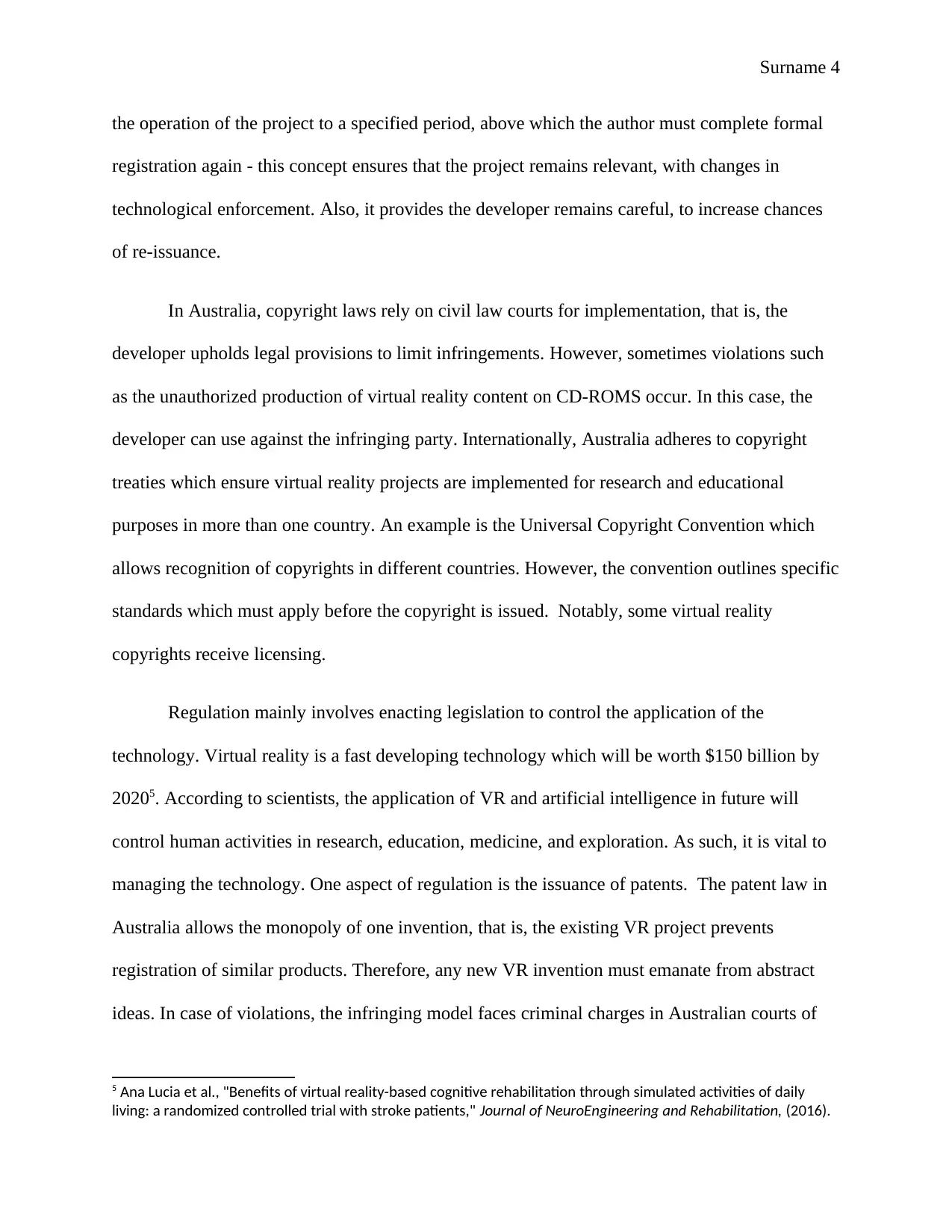
Surname 4
the operation of the project to a specified period, above which the author must complete formal
registration again - this concept ensures that the project remains relevant, with changes in
technological enforcement. Also, it provides the developer remains careful, to increase chances
of re-issuance.
In Australia, copyright laws rely on civil law courts for implementation, that is, the
developer upholds legal provisions to limit infringements. However, sometimes violations such
as the unauthorized production of virtual reality content on CD-ROMS occur. In this case, the
developer can use against the infringing party. Internationally, Australia adheres to copyright
treaties which ensure virtual reality projects are implemented for research and educational
purposes in more than one country. An example is the Universal Copyright Convention which
allows recognition of copyrights in different countries. However, the convention outlines specific
standards which must apply before the copyright is issued. Notably, some virtual reality
copyrights receive licensing.
Regulation mainly involves enacting legislation to control the application of the
technology. Virtual reality is a fast developing technology which will be worth $150 billion by
20205. According to scientists, the application of VR and artificial intelligence in future will
control human activities in research, education, medicine, and exploration. As such, it is vital to
managing the technology. One aspect of regulation is the issuance of patents. The patent law in
Australia allows the monopoly of one invention, that is, the existing VR project prevents
registration of similar products. Therefore, any new VR invention must emanate from abstract
ideas. In case of violations, the infringing model faces criminal charges in Australian courts of
5 Ana Lucia et al., "Benefits of virtual reality-based cognitive rehabilitation through simulated activities of daily
living: a randomized controlled trial with stroke patients," Journal of NeuroEngineering and Rehabilitation, (2016).
the operation of the project to a specified period, above which the author must complete formal
registration again - this concept ensures that the project remains relevant, with changes in
technological enforcement. Also, it provides the developer remains careful, to increase chances
of re-issuance.
In Australia, copyright laws rely on civil law courts for implementation, that is, the
developer upholds legal provisions to limit infringements. However, sometimes violations such
as the unauthorized production of virtual reality content on CD-ROMS occur. In this case, the
developer can use against the infringing party. Internationally, Australia adheres to copyright
treaties which ensure virtual reality projects are implemented for research and educational
purposes in more than one country. An example is the Universal Copyright Convention which
allows recognition of copyrights in different countries. However, the convention outlines specific
standards which must apply before the copyright is issued. Notably, some virtual reality
copyrights receive licensing.
Regulation mainly involves enacting legislation to control the application of the
technology. Virtual reality is a fast developing technology which will be worth $150 billion by
20205. According to scientists, the application of VR and artificial intelligence in future will
control human activities in research, education, medicine, and exploration. As such, it is vital to
managing the technology. One aspect of regulation is the issuance of patents. The patent law in
Australia allows the monopoly of one invention, that is, the existing VR project prevents
registration of similar products. Therefore, any new VR invention must emanate from abstract
ideas. In case of violations, the infringing model faces criminal charges in Australian courts of
5 Ana Lucia et al., "Benefits of virtual reality-based cognitive rehabilitation through simulated activities of daily
living: a randomized controlled trial with stroke patients," Journal of NeuroEngineering and Rehabilitation, (2016).
Paraphrase This Document
Need a fresh take? Get an instant paraphrase of this document with our AI Paraphraser
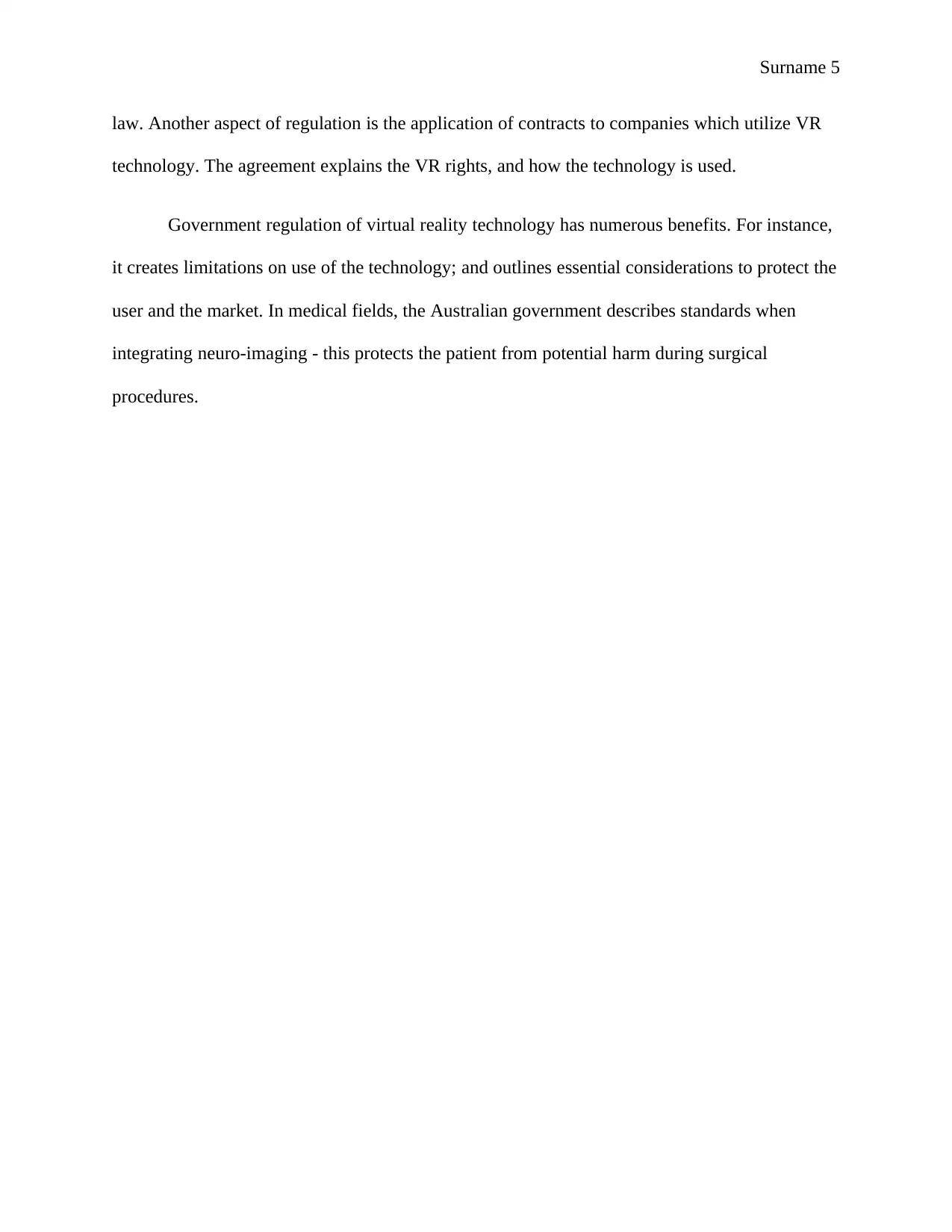
Surname 5
law. Another aspect of regulation is the application of contracts to companies which utilize VR
technology. The agreement explains the VR rights, and how the technology is used.
Government regulation of virtual reality technology has numerous benefits. For instance,
it creates limitations on use of the technology; and outlines essential considerations to protect the
user and the market. In medical fields, the Australian government describes standards when
integrating neuro-imaging - this protects the patient from potential harm during surgical
procedures.
law. Another aspect of regulation is the application of contracts to companies which utilize VR
technology. The agreement explains the VR rights, and how the technology is used.
Government regulation of virtual reality technology has numerous benefits. For instance,
it creates limitations on use of the technology; and outlines essential considerations to protect the
user and the market. In medical fields, the Australian government describes standards when
integrating neuro-imaging - this protects the patient from potential harm during surgical
procedures.
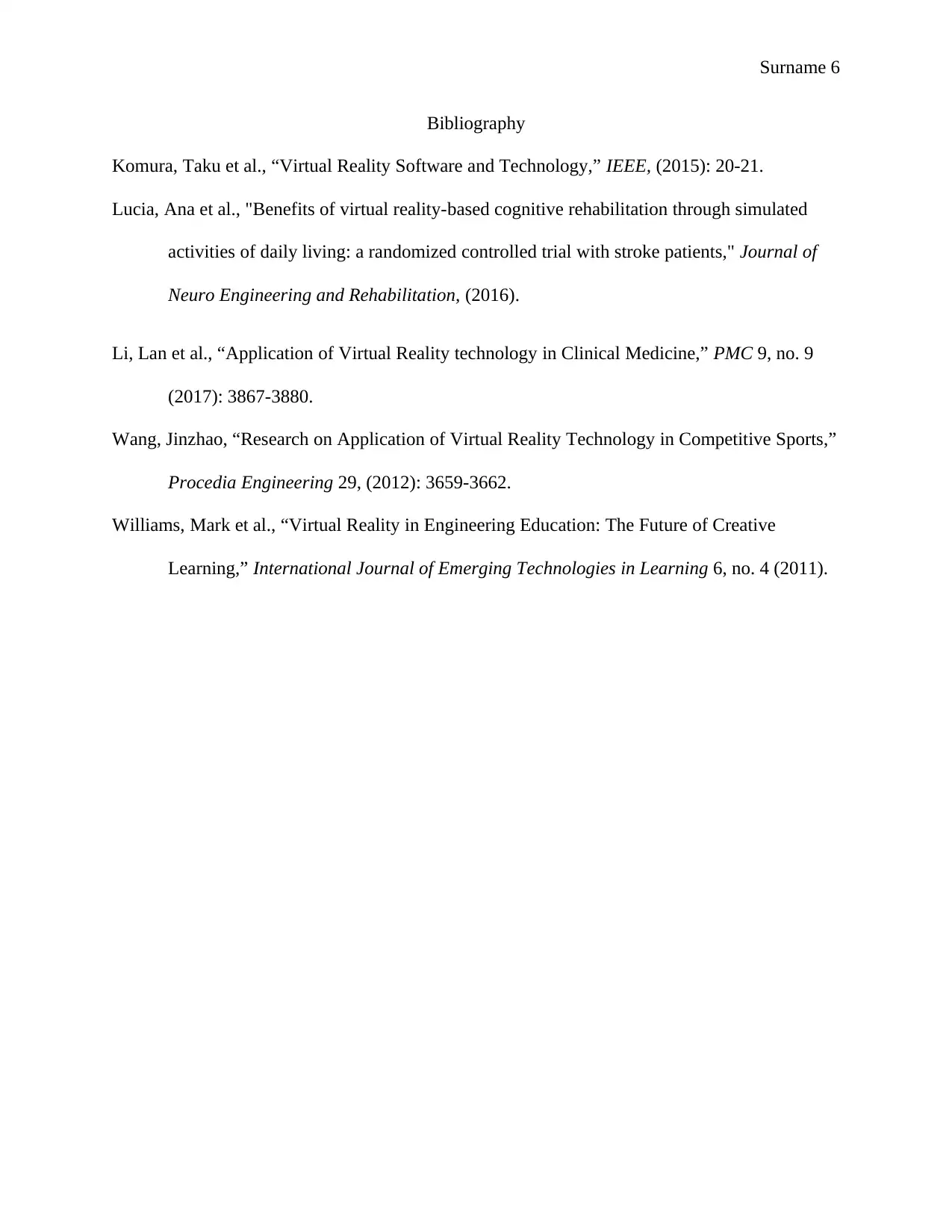
Surname 6
Bibliography
Komura, Taku et al., “Virtual Reality Software and Technology,” IEEE, (2015): 20-21.
Lucia, Ana et al., "Benefits of virtual reality-based cognitive rehabilitation through simulated
activities of daily living: a randomized controlled trial with stroke patients," Journal of
Neuro Engineering and Rehabilitation, (2016).
Li, Lan et al., “Application of Virtual Reality technology in Clinical Medicine,” PMC 9, no. 9
(2017): 3867-3880.
Wang, Jinzhao, “Research on Application of Virtual Reality Technology in Competitive Sports,”
Procedia Engineering 29, (2012): 3659-3662.
Williams, Mark et al., “Virtual Reality in Engineering Education: The Future of Creative
Learning,” International Journal of Emerging Technologies in Learning 6, no. 4 (2011).
Bibliography
Komura, Taku et al., “Virtual Reality Software and Technology,” IEEE, (2015): 20-21.
Lucia, Ana et al., "Benefits of virtual reality-based cognitive rehabilitation through simulated
activities of daily living: a randomized controlled trial with stroke patients," Journal of
Neuro Engineering and Rehabilitation, (2016).
Li, Lan et al., “Application of Virtual Reality technology in Clinical Medicine,” PMC 9, no. 9
(2017): 3867-3880.
Wang, Jinzhao, “Research on Application of Virtual Reality Technology in Competitive Sports,”
Procedia Engineering 29, (2012): 3659-3662.
Williams, Mark et al., “Virtual Reality in Engineering Education: The Future of Creative
Learning,” International Journal of Emerging Technologies in Learning 6, no. 4 (2011).
⊘ This is a preview!⊘
Do you want full access?
Subscribe today to unlock all pages.

Trusted by 1+ million students worldwide
1 out of 6
Your All-in-One AI-Powered Toolkit for Academic Success.
+13062052269
info@desklib.com
Available 24*7 on WhatsApp / Email
![[object Object]](/_next/static/media/star-bottom.7253800d.svg)
Unlock your academic potential
Copyright © 2020–2025 A2Z Services. All Rights Reserved. Developed and managed by ZUCOL.

